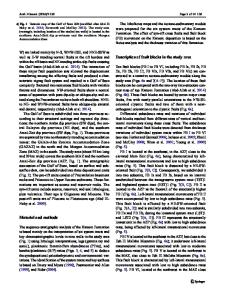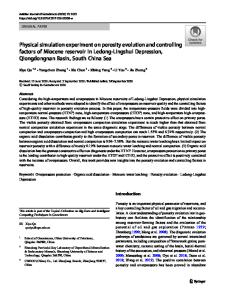Evolution of Ordovician cephalopod diversity in the Middle Yangtze region of South China and its controlling factors
- PDF / 2,607,302 Bytes
- 10 Pages / 595.276 x 790.866 pts Page_size
- 2 Downloads / 280 Views
ORIGINAL PAPER
Evolution of Ordovician cephalopod diversity in the Middle Yangtze region of South China and its controlling factors Zhenyu Song 1 & Chuantao Xiao 1 Received: 28 September 2019 / Accepted: 1 November 2020 # Saudi Society for Geosciences 2020
Abstract The evolution of Ordovician cephalopod diversity in the Middle Yangtze region of South China has been analysed. The cephalopods in this region appeared in the earliest Tremadocian, radiated in the Early–Middle Floian and Middle Ordovician, and went through an extinction period during the Late Katian and Hirnantian. The composition of the cephalopod fauna underwent major changes in the Late Floian. Specifically, all the genera occurring in previous time periods disappeared and Tarphyceratida, Actinoceratida, and Orthoceratida appeared and prospered. Differences in the evolution of cephalopod diversity between Middle Yangtze region and other regions were detected, which were caused by differences in the vertical sequence and horizontal combination of controlling factors. Changes in living environments and the distribution of food resources prompted Ordovician cephalopods to evolve adaptations for life in deep-water environments. The low-temperature ocean current near the western coastline of Gondwana created favourable conditions for the Floian peak of cephalopod diversity in South China. The tectonic movements, high rainfall, and relatively closed environment of the Middle Yangtze region led to rapid sea level rise and hindered cephalopod diversification. These processes explain the low cephalopod diversity in the Late Ordovician and the absence of the previously reported Katian radiation peak in this region. Keywords Cephalopod . Ordovician . Richness trends . Middle Yangtze region . Controlling factors
Introduction The two major biological events of the Ordovician, the Great Ordovician Biodiversification Event (GOBE) and the Late Ordovician Mass Extinction (LOME), are popular topics of current international geological research. The GOBE represented a dramatic increase in global metazoan diversity (Sepkoski and Sheehan 1983), one of the major events in marine organism evolution, and facilitated the vast ecosystem change that paved the way for the Palaeozoic Evolutionary Fauna (Sepkoski 1979, 1981; Webby et al. 2004b; Servais et al. 2008, 2010). In recent years, the GOBE has received considerable attention. Stigall et al. (2019) suggested using the expression “Ordovician Radiation” when referring to the Responsible Editor: Attila Ciner * Chuantao Xiao [email protected] 1
Geosciences School of Yangtze University, No. 111, University Road, 430100 Caidian District, Wuhan, Hubei Province, China
broader diversification that occurred throughout the Ordovician and restricting the term “GOBE” to indicate the rapid diversification and ecosystem change centred on the Darriwilian age. The GOBE took place during a short period spanning just 15 Myr (Rasmussen et al. 2019). The causes and controlling factors of this event are the focus and primary challenge o
Data Loading...











